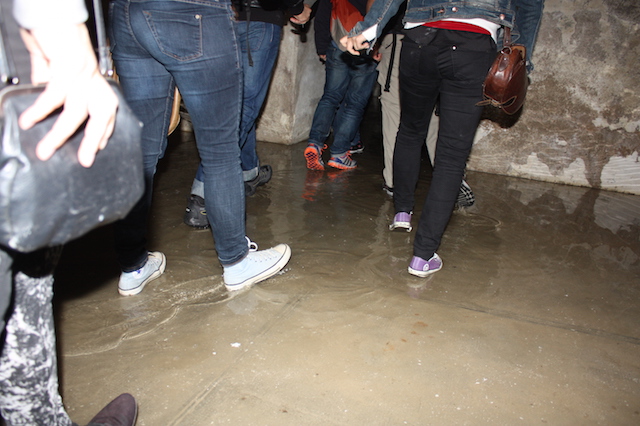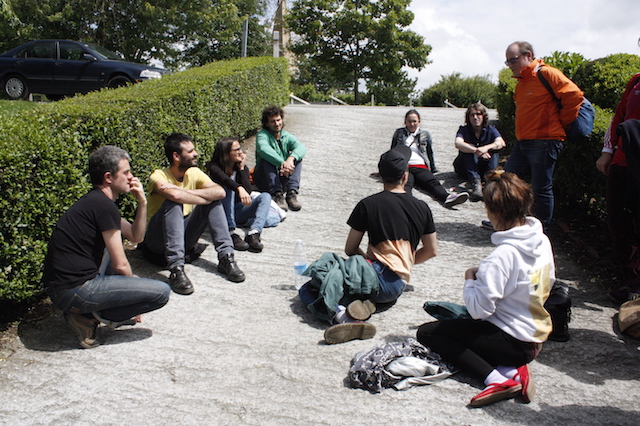A Polyphony of Time
“After the previous day’s conversation, I still had an image in my head of a star-shaped bastion with walls towering above a precise geometrical ground-plan, but what I now saw before me was a low-built concrete mass, rounded at all its outer edges and giving the gruesome impression of something hunched and misshapen: the broad back of a monster, I thought, risen (…) like a whale from the deep (…)”.
W.G. Sebald: Austerlitz (2001)
A Polyphony of Time offers the conditions for the development of a meeting at the fort of Guadalupe in Hondarribia between 18:00 of the 22nd of June and 18:00 of he 23rd of June of 2013. It is a project by Bulegoa z/b for Tratado de Paz, a program curated by Pedro G. Romero*, that proposes spending time for reflection throughout 24 hours. In order to do so, 24 people have been invited to take over a portion of time during the day.
The time distribution and the structure of the meeting will emerge on site, through dialogue between the guests and those who wish to attend. Other questions to deal with are: how to break with the order of the productive system’s normative time; how to think about the dichotomy between waiting time and the time of the event; how to produce states of duration and wasted time; how to reflect on the organisation of time given by a continuous 24 hour workday, where divisions between productive and useless time become indiscernible.
There are many aspects that make the fort of Guadalupe in Hondarribia a singular stage for the meeting proposed by A Polyphony of Time: its location up high and on its borderline character; its relative isolation and its distance from the urban environment; its original and premature anachronism and uselessness; its unusual appearance, partially buried and covered by vegetation; the excessively literal image of the fort and its association with ideas such as frontier, inside and outside, the self and the other.
The history of the fort of Guadalupe in Hondarribia helps to explain this singularity. The complex was built in 1900 following a system of trenches; a series of permanent armed forts located on prominent points of a territory, supporting military forces from its surroundings. The construction is one of a series of forts. Due to economic reasons, only three of these were built, with the purpose of protecting the territory of Gipuzkoa from two potential threats: a possible invasion from the other side of the border, and a Carlist uprising within the territory.
Born at the beginning of the 20th Century, the fort of Guadalupe in Hondarribia did not turn out to be a product of its time, but of the century preceding it. The architectural complex was already anachronistic and obsolete when it was built, and was never used for the functions it had been designed for. Neither of the two situations of conflict ever took place. On the other hand, the construction techniques and the design of the trenches were not capable of answering to the new concept of war of the 20th Century. The fort of Guadalupe in Hondarribia was built at a time when the rest of Europe was starting to use new construction materials and technology (reinforced concrete, steel hoods, underground shelters) that were compatible with the new idea of war that was being intensively tested on the other side of the border during World War One.
The anachronism at the origin of the fort goes together with a timeless quality, which comes from its state of partial abandon and its unusual current appearance. Nature and vegetation thus cover the buried building, producing a flat and dull landscape. If one looks at it carefully, the forms that time has blurred soon begin to appear and become legible.
The locations chosen for the day are located outside the fort, near its entrance: the premises of the Guard Corps and the open field at the doorway where the Hondarribia Parade is celebrated every year. A diversity activities can be carried out in both locations, such as readings, screenings, walks, shared reflections or ephemeral installations of sculptures and other art objects. A Polyphony of Time proposes a continuous workday that might suspend time without adopting a conventional form.
Participating guests at A Polyphony of Time: Elena Aitzkoa, Lorea Alfaro, ANTespacio (Laura Díez, Melodie Martín), Ibon Aranberri, Jesús Arpal Moya, Jesús Arpal Poblador, Aimar Arriola, Josu Bilbao Ugalde, June Crespo, Marion Cruza, Oier Iruretagoiena, Gabriela Kraviez and Juan Pérez Agirregoikoa, Jon Mantzisidor, Alex Mendizabal, Musta Props, Mikel Ochoteco, Ángela Palacios, Sarah Rasines, Irantzu Sanzo, Marcos Urquijo, Cristian Villavicencio, Esteban Zamora (Kaxilda).
*Peace Treaty is a project for San Sebastian European Capital of Culture 2016. 1813. Siege, Fire and Reconstruction of San Sebastian, its first presentation, is being organised by the DSS2016 Foundation and the San Telmo Museum; co-produced by the Naval Museum and Peace and Human Rights Centre in San Sebastian, and the Zumalakarregi Museum in Ormaiztegi; with the cooperation of the Basque Museum and of the history of Bayonne, the National Library and Museum of Calcography, the Prado Museum and the Reina Sofia National Art Museum in Madrid.
Time: from 18:00 of the 22nd of June until 18:00 of the 23rd of June of 2013.
Location: premises of the Guard Corps of the fort of Guadalupe in Hondarribia, the open field at the fort’s entrance, and surrounding area.
If you wish to receive further information, please write to bulegoa@bulegoa.org
Co-producers:





Institutions:






















